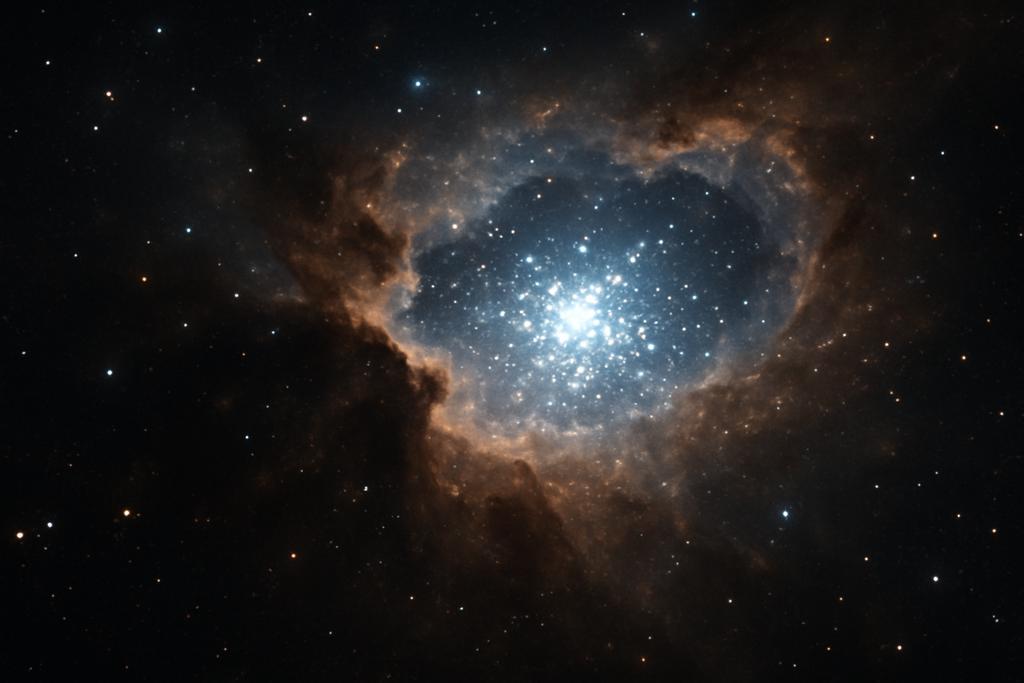Imagine a colossal cosmic blowtorch, not of fire, but of stellar winds. This isn’t some sci-fi fantasy; it’s the reality of young, massive star clusters, where hundreds of stars, each a powerhouse of radiation and expelled matter, collectively carve out enormous cavities in the surrounding interstellar medium. A new semi-analytic model, developed by Stanley P. Owocki of the Bartol Research Institute, Department of Physics & Astronomy, University of Delaware, offers a fresh perspective on these powerful outflows, revealing surprising robustness in the dynamics of these stellar gales.
The Symphony of Stellar Winds
These star clusters aren’t just random collections; they’re densely packed societies of massive stars, each with incredibly powerful stellar winds. These winds aren’t gentle breezes; they’re supersonic torrents of plasma, often exceeding 3,000 kilometers per second. When these winds collide, they generate a maelstrom of energy, primarily in the form of heat. This thermal energy is the driving force behind the cluster outflow, a collective wind-blown bubble expanding into space. Think of it like a gigantic, galactic-scale bonfire, with each star contributing its fiery breath to the overall inferno.
Beyond Power Laws and Exponentials
Previous models often simplified the process by assuming either a power-law or exponential distribution of mass deposition from the stellar winds. Owocki’s work, however, generalizes these approaches. The beauty of this new model lies in its ability to handle a far broader range of mass deposition scenarios, moving beyond the constraints of these simplistic functions. This increased flexibility allows for more realistic modeling of the outflow, incorporating nuances not captured in earlier research.
The Sonic Point: A Crucial Crossroads
The model pinpoints a critical, or sonic, radius within the cluster. At this point, the outflow transitions from subsonic to supersonic speeds. This sonic radius is a critical component in solving for the flow’s velocity, density, and temperature throughout the cluster. The model elegantly identifies this point a priori, making it significantly easier to obtain accurate solutions through straightforward inward and outward integration. This simplicity is a major advancement, simplifying the process compared to previous, more complex numerical methods.
The Unexpected Similarity of Outflows
One of the most surprising findings is the remarkable similarity of velocity variations across different mass deposition models. Regardless of whether the mass is distributed according to a Gaussian curve, an exponential decay, or following the empirically derived models proposed by Plummer and Elson, the overall velocity profile exhibits a striking consistency. When scaled appropriately, the velocity profiles—from a near-zero speed at the origin to a terminal speed set by the mass-weighted average stellar wind—show almost identical patterns. This robustness suggests that the overall cluster outflow is remarkably insensitive to the details of the stellar wind distribution.
Radiative Cooling: A Minor Player
The model accounts for radiative cooling, but finds it to be a relatively minor effect, particularly for realistic mass loss rates from young star clusters. Previous models had difficulty reconciling observed X-ray emissions with the expected output from fully thermalized winds. This new model provides a valuable tool to further investigate this discrepancy. The finding of minor radiative losses points towards alternative explanations for the subdued X-ray luminosity, focusing attention on factors like incomplete thermalization or other physical processes at play.
Incomplete Thermalization: A Complicating Factor
The model also explores the effects of incomplete thermalization of the stellar winds. In reality, not all wind collisions result in complete energy conversion to heat. Some momentum from the winds is directly transferred to the outflow, altering the dynamics. While the model suggests this effect may not drastically alter the overall velocity profile, it highlights a crucial area for future investigation. Further numerical simulations are needed to fully understand the extent of this incomplete thermalization and its impact on the overall dynamics.
Implications and Future Directions
Owocki’s semi-analytic model provides a powerful tool for understanding the complex dynamics of stellar wind outflows. Its ability to handle a wide range of mass deposition models and account for both radiative cooling and incomplete thermalization allows for more realistic simulations. The model’s predictive power extends to X-ray emissions, providing a robust framework for analyzing observed data and resolving discrepancies between theory and observation. Future research using this model should delve deeper into the effects of incomplete thermalization and examine the transition from fully thermalized flows to those with more sparse stellar wind sources, moving beyond the simplified assumptions of current models. This enhanced understanding will not only refine our knowledge of stellar cluster evolution but could also offer new insights into the formation and dynamics of galaxies.










